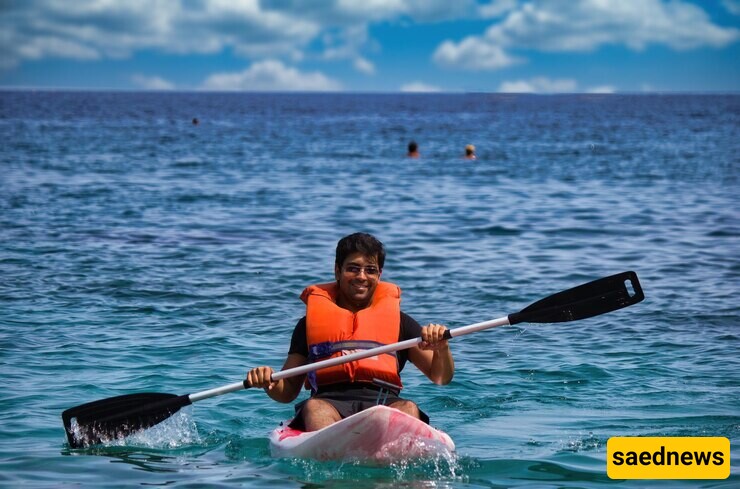SAEDNEWS: In today's world of sports, many disciplines are water-based. Swimming and rowing are among the primary ones. However, many subcategories of these two sports have shifted from competitive and athletic arenas to recreational activities for everyday people.


Many water sports, popular during warmer seasons, have athletic and competitive roots. Although competitions for these sports still occur globally, they have captured the interest of the general public. Jet skiing, for instance, is a favorite summer pastime. Besides seaside areas, artificial lakes have become popular spots for jet ski activities.
Some of these recreational activities demand effort, skill, and proper training. For example, sailing isn't just about using wind power to move a boat; it also requires skills like navigation. These activities have gained attention in Iran recently, with the Caspian Sea and the Persian Gulf serving as primary hubs. The Caspian beaches are ideal during summer, while the Persian Gulf's shores are more suitable in winter. However, most of these water-based sports are expensive, making them inaccessible to all social classes. The novelty and imported nature of the equipment have contributed to their high costs.

One of the most popular recreational water sports worldwide is sailing. These wind-powered boats traverse vast seas and oceans, covering various distances. Sailing can be enjoyed individually or in groups. Historically, sailboats were among the earliest tools used by humans for transportation and warfare, transitioning into recreational and competitive uses over time.
Modern sailing operates under international federations and is especially popular along the coasts of Europe and Australia. In Iran, sailing is relatively new, with Bandar Lengeh and Nowshahr as its main hubs. However, the high cost of equipment makes sailing an exclusive activity.

Rafting, a thrilling water sport, has recently grown as a recreational activity. It involves large inflatable rafts that navigate turbulent river waters, often with multiple participants. Rafting falls under the competitive umbrella of slalom sports and is both exhilarating and risky, with six levels of proficiency. Long, rocky river courses are typical locations for rafting, with environmental agencies ensuring their preservation.
While kayaking in turbulent waters shares similarities, it remains primarily a competitive activity. Kayak races require exceptional balance and are typically not considered recreational.

Water skiing is an adrenaline-filled sport where participants, wearing specialized skis, are pulled by motorized watercraft at speeds of approximately 30 km/h. The activity requires exceptional upper and lower body strength, balance, and endurance.
Water skiing has various styles, such as barefoot skiing, trick skiing, and jump skiing. Originating in the United States, it was first practiced in 1922 when Ralph Samuelson experimented with wooden skis and a rope in Lake City, Minnesota. In Iran, water skiing is gaining popularity, especially in the northern and southern regions, under the supervision of the rowing federation.

Jet skiing, initially a brand name by Kawasaki, has evolved into a recreational and competitive activity. These small, fast watercraft can accommodate one or two people. Balancing and quick reflexes are crucial for handling jet skis effectively. In Iran, jet skiing has been around for nearly a decade, gaining significant traction recently. Coastal and artificial lake resorts offer jet skiing as a relatively affordable water activity compared to other sports.

Diving, along with underwater photography, has become a popular recreational activity in Iran over the past decade. Iran's diving federation has developed facilities along the Caspian Sea and the Persian Gulf. While diving has industrial, research, and military applications, it is now widely practiced for leisure and tourism.
There are various diving techniques:
Free Diving: This challenging sport relies on holding one's breath without external oxygen.
Scuba Diving: Divers use compressed air cylinders to explore underwater.
Surface-Supplied Diving: Oxygen is supplied from the surface via a hose, often used for industrial purposes.
Saturation Diving: Divers stay underwater for extended periods, living in pressurized habitats between dives.
Diving is an ancient activity, historically used for pearl hunting, but modern advances have made it safer and more accessible.

Fishing has transitioned from a survival activity to a recreational pastime. It can be classified into:
Commercial Fishing: Conducted on a large scale using modern equipment, it significantly impacts marine ecosystems.
Recreational Fishing: Involves traditional or modern techniques, such as spearfishing or using bait, and serves as a relaxing and enjoyable outdoor activity.
Environmental agencies regulate harmful fishing practices, such as electric shock or explosives.

Parasailing combines water and aerial recreation. Participants are attached to a parachute, which is pulled by a motorboat, gradually lifting them into the air. As the boat accelerates, the parachute ascends, offering breathtaking views and an exhilarating experience.

